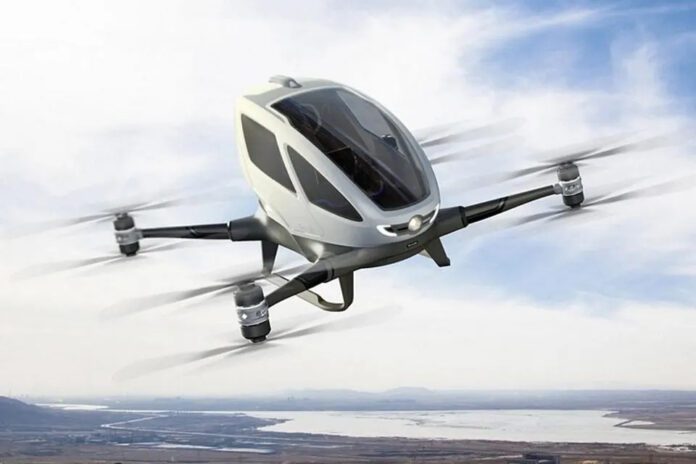Introduction
The year 2023 marked a significant milestone in the realm of transportation, as the Chinese company EHang achieved a groundbreaking feat by conducting the first commercial flight of its unmanned, autonomous passenger drone in Guangzhou. This development sparked excitement and curiosity about the prospect of flying cars becoming a reality. However, as we delve into the details of this technological leap, it becomes evident that while progress is being made, there are still notable challenges to overcome.
The EH216-S: A Glimpse into the Future
On December 28, 2023, EHang’s EH216-S took to the skies, showcasing a futuristic vision of personal aerial transportation. The electric-powered drone, equipped with 16 rotors, successfully transported a human passenger without the need for a pilot. Despite its achievement, the EH216-S is not without its limitations. With a range of only 22 miles and a top speed of 81 mph, it falls short of the capabilities offered by traditional helicopters, such as the Robinson R44. While it may be quieter and greener, questions arise about its practicality and feasibility as a widespread mode of transportation.
Technical Specifications of the EH216-S
- Autonomy: Completely unmanned and autonomous
- Power Source: Electric battery
- Range: 22 miles
- Top Speed: 81 mph
- Passenger Capacity: Two passengers
A Historical Perspective: Where Are Our Flying Cars?
The notion of flying cars is not new, with historical attempts dating back to the 1930s. Early aviation pioneers, including Juan de la Cierva and Harold Pitcairn, introduced the “autogyro,” a precursor to the helicopter. These vehicles had the ability to traverse long distances and even drive on regular roadways. However, the autogyro’s prominence was short-lived, primarily due to the economic challenges of the Depression and the diversion of resources during World War II.
The Autogyro Era
- Pioneers: Juan de la Cierva and Harold Pitcairn
- Key Features: Rotor-based propulsion, ability to drive on roads
- Prominence: Brief moment in the 1930s
- Setbacks: Economic challenges during the Depression and resource diversion in World War II
Overcoming Technical Hurdles: Flying Car Concepts Throughout History
Efforts to create flying cars persisted over the decades, with various designs attempting to blend the functionalities of planes and automobiles. From the Aerocar of 1946 to the “Flying Jeep” of 1959, inventors explored innovative solutions. However, technical challenges and regulatory obstacles hampered the realization of a world where flying cars were commonplace.
Noteworthy Attempts
- Aerocar (1946): A car with wings, attempting to combine road and air travel.
- Flying Jeep (1959): Exploring the integration of flight capabilities into a versatile vehicle.
- Hiller Flying Platform: An experimental circular platform for airborne infantry transport.
Social Barriers: The True Challenge to Flying Cars
The vision of flying cars soaring through the skies has long captivated human imagination, but as technology advances, the true challenges to the realization of this dream are revealed to be more social than technical. J. Storrs Hall’s insights into the “idiotic fear of energy” and the societal hesitations towards embracing new technologies highlight a set of complex social barriers that must be navigated for the widespread adoption of flying cars.
Cultural Reaction: Overcoming Fear and Hesitation
One significant social barrier is the prevailing cultural reaction, often characterized by an unwarranted fear of energy and technological innovation. The unfamiliarity and perceived risks associated with autonomous passenger drones contribute to skepticism and reluctance among the public. Addressing this cultural reaction requires not only showcasing the safety and reliability of the technology but also a concerted effort in educating and familiarizing the public with the advancements in aerial mobility.
Perception of Safety
- Public Awareness: Lack of understanding about the safety features and redundancy systems in autonomous flying vehicles.
- Communication: Bridging the gap between technical experts and the general public to dispel misconceptions.
- Demonstration: Conducting transparent and high-profile flight demonstrations to showcase the technology’s safety.
Regulatory Ossification: Adapting to a Changing Landscape
Regulatory frameworks designed for traditional modes of transportation may prove inadequate for the unique challenges posed by flying cars. The rigid and often outdated regulations present a formidable barrier, hindering the seamless integration of autonomous passenger drones into existing airspace. The slow pace of regulatory adaptation to emerging technologies requires proactive efforts from both industry stakeholders and regulatory bodies.
Regulatory Flexibility
- Collaboration: Establishing open channels of communication between industry leaders and regulatory agencies.
- Pilot Programs: Implementing pilot programs to test and refine regulatory frameworks for aerial mobility.
- International Cooperation: Facilitating collaboration on a global scale to establish standardized regulations for flying cars.
Navigating the Future: EHang and Beyond
As EHang takes its EH216-S to the skies, other companies like Joby, Wisk Aero, and LIFT’s Hexa are also making strides in the development of passenger drones. These advancements signal the potential transformation of urban transportation, but critical questions about social acceptance and practicality remain unanswered.
Rivals in the Sky
- Joby: A key player in the race for aerial mobility solutions.
- Wisk Aero: Contributing to the progress of electric vertical takeoff and landing (eVTOL) technology.
- LIFT’s Hexa: Exploring innovative solutions in the passenger drone sector.
Imagining the Future: Challenges and Opportunities
The vision of a world filled with flying cars raises exciting possibilities, but it also presents challenges that must be addressed. Public trust in self-piloted drones, the availability of heliports, and the acceptance of air taxi fleets in densely populated urban areas all hinge on societal attitudes and regulatory frameworks.
Shaping the Future
- Public Trust: Addressing concerns and building confidence in autonomous passenger drones.
- Heliport Infrastructure: Evaluating the existing infrastructure and its suitability for widespread air taxi use.
- Urban Acceptance: Gauging the tolerance of residents in dense urban areas towards the noise and presence of air taxi fleets.
Conclusion: Steering Towards a Skyborne Future
While the EH216-S and its counterparts offer a glimpse into a future where the skies are filled with passenger drones, the journey towards widespread adoption is filled with challenges. The shift towards flying cars is not just a technological endeavor; it requires a collective effort to shape societal attitudes, address regulatory concerns, and actively pave the way for a new era of transportation. The dream of flying cars is within reach, but it is the choices we make today that will determine whether we embrace this transformative future.










